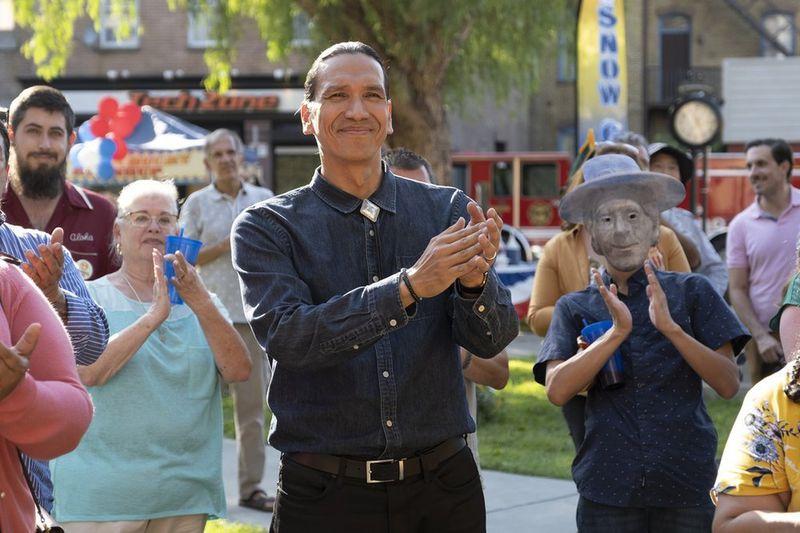Column: Why hiring Native Americans to tell their own stories makes for better — and truer — TV and movies


After delays resulting from the pandemic, Martin Scorsese’s latest projectbegan filmingin Oklahoma this week.
A 1920s crime drama adapted from David Grann’snonfiction book“Killers of the Flower Moon,” it tells the true story behind the deaths of at least two dozen members of the Osage Nation. They were systematically murdered for control over their wealth, which was derived from oil-rich land on their reservation, and it was one of the first cases investigated by the FBI.
The screenplay is fromOscar-winning“Forrest Gump” screenwriter Eric Roth and Scorsese, but no credited Native screenwriters are involved. This is surprising.
The film is being made for Apple TV+ and a press release from the streaming platform notes that tribal leaders were instrumental in introducing the filmmakers to “cultural advisers, historians, local artisans and citizens to assist in their efforts to portray the story with authenticity and honesty.”
That’s great.
But consider this point made by 28 Native American and Indigenous screenwriters in anopen letterto Hollywood this past October:
“We call on our colleagues to move beyond the limiting practice of only hiring us as cultural consultants.”
Consultants are just that: Consultants. They do not receive screenwriting residuals. Or major awards consideration. Or more importantly, occupy a power position to determine how a story is told.
Grann is a popular writer. You might say: His 2017 book was respectful in its meticulously researched indictment of white supremacy. Scorsese is a renowned filmmaker. You might say: I trust him to get it right.
But why are any non-Natives — even those with the best intentions — owed the benefit of the doubt when TV and moviemakers have such a long and sordid history of getting it absolutely wrong? Since the dawn of film, Hollywood has been trampling over Native Americans to tell their stories, as if Indigenous people exist as characters to be interpreted, or rather misinterpreted, through a white person’s lens.
Whynothire Native screenwriters to tell Native stories? Won’t that always result in something more nuanced and complicated and true — and ultimately more interesting?
According to the Writers Guild of America,as of last yearNative Americans comprised just 1.1% of working TV writers and 0.8% of employed screenwriters. Those numbers aren’t low because there aren’t enough writers. Thereare.
The new Peacock comedy series“Rutherford Falls”premieres this week and it employs five Native American writers, including co-creator Sierra Teller Ornelas, who is Navajo and Mexican American.
Her previous credits include “Superstore” and “Brooklyn Nine-Nine,” and here she has teamed up with star Ed Helms (“The Office”) and producer Michael Schur (creator of “Parks and Recreation” and “The Good Place”) on a story of two lifelong friends who see their bond tested because of tensions between the small town of Rutherford Falls and the neighboring tribe.
Helms plays Nathan, who runs the local museum. He is a proud descendant of the white settler who founded the town and clings to a whitewashed version of history — and resists examining that further. He’s a fundamentally decent-hearted person but obsessed with the family legacy and he cannot get out of his own way and see where he’s gone wrong.
He is lifelong friends with Reagan, played by Jana Schmieding, a Cheyenne River Lakota Sioux actor who is also a writer on the show. Reagan is a Northwestern alum with two masters degrees who has returned to her tribal community, where she now runs the cultural center. It’s an overlooked, sparsely-filled space tucked into a corner of the Running Thunder Casino, where it’s often mistaken for the gift shop. Schmieding is a real talent, finding just the right balance of self-deprecation and confidence for the character.
Things become more complicated when Reagan begins an unlikely friendship with the astute casino boss Terry (played by the terrific Michael Greyeyes, who is Muskeg Lake Cree). He puts a plan in motion to right several centuries of wrongs by suing Nathan and the deep-pocketed multinational corporation that bears his family name. Like “Superstore” and “Parks and Recreation,” the show has a deep bench of finely drawn supporting characters who help fill out this world.
The show’s Minishonka tribe, though, is fictional. That was intentional: “I think amongst Native communities, it’s a bummer when things aren’t specific because there are over 500 federally recognized Native nations in the United States. They all have their own governments, their own culture, religion, language,” Teller Ornelastoldthe Hollywood Reporter.
“The main focus,” she said, “not just in terms of the Native representation, but also the Native comedy on our show, is to show the Native people aspeople. No one turns into mythical creatures on our show. It was very important to me that we have regular lives and regular jobs. Our lives are specific (and) there are Native specifics that I’m not even sure everyone is going to get when they watch. But they are accurate to my experience and the experiences of other native writers on the show. So it was always to make sure we were in on the joke, one, and also reflective of modern Native experience.”
If “Rutherford Falls” is a rebuke of all those twisted stereotypes that have been the norm, a1990episodeof “Saved by the Bell” called “Running Zack” is emblematic of them. StarMark-Paul Gosselaar(aka Zack Morris) recently went back and analyzed the episode foran installment of the podcast“Zack to the Future,” which he co-hosts with Dashiell Driscoll.
“Saved by the Bell” was a Saturday morning favorite among Millennials, but Gosselaar hasn’t watched any of it since he walked off the set 25-plus years ago. So he’s revisiting the show with new eyes and on the podcast he is refreshingly (enjoyably) willing to criticize all of it, including the writers and himself. Even so, he admits to anxiety about discussing this particular episode: The kids are researching their ancestry for a school assignment and Zack finds a picture of a Native American in an old family trunk. In class, he gives a presentation that is awash in stereotypes before his teacher introduces him to a man named Chief Henry, who helps him connect with his Native heritage.
“I cringed,” Gosselaar says, “seeing myself portray a white dude — being Zack Morris, who is the All-American blonde-haired white dude — in an Indian Native American headdress.”
Gosselaar’s mother is Indonesian and his father is Dutch; as a result he and Driscoll jokingly refer to themselves as “one-and-a-half white guys.” They are joined on the podcast by actor and comedianTatanka Means(Navajo, Oglala Lakota and Omaha) who remembers watching the show in its original run and offers his own perspective and critiques of the Native storyline.
Chief Henry is played byDehl Berti, a Chiricahua Apache actor who died a year after “Running Zack” aired, and on the podcast the hosts and Means speculate about whether Berti felt any internalized pressure to push back or correct the show’s portrayal of Native people — and how unfair it is that any Native actor is put in that position to begin with.
“As American Indian people, when you’re hired as an actor, everybody goes to you (because) you’re that Native representative,” Means says. “You become the consultant. You’re doing everybody else’s jobs. Normally six other people would have been hired. You’re doing costumes. You’re doing props. Even doing language. People just expect you to know how to speak whatever tribe you’re playing.”
The hosts seem confident that something as flagrantlyoffas “Running Zack” would never get made today. But Means challenges that: “I don’t know, we’re still getting thrown under the bus. I wouldn’t be surprised if something like that came out (now).”
You don’t have to look far to find an example.
Last month, the fourth season of the UK-produced reality show“The Great Pottery Throw Down”premiered on HBO Max. One episode in particular is focused on North American Acoma pottery.
On Twitter, Debbie Reese (Nambé Pueblo)noted her concerns: “It starts out with ‘turning back the clock’ and past tense verbs about Acoma. That’s a problem right off the bat. Books, TV shows, etc. depict Native peoples in the past, using past tense verbs, as if we no longer exist.”
The firing technique for the pottery uses dung as fuel and Reese isn’t impressed with the squeamish immaturity from everyone on camera: “The potters (they’re white) and hosts (they’re not Native) are acting like kids over a firing technique that uses manure.”
Watching the episode, my mind went back to that October letter from the 28 Native Writers Guild members, who point out the ways they’ve been excluded from industrywide diversity promises: “Across film and television we continue to see Native and Indigenous stories told by nonnative writers who perpetuate inaccurate and racist representations.”
Too often the default is still to portray Native characters “in time capsules, as mythical creatures, spirit guides and victims of horrific trauma.”
Which is why a series like Peacock’s “Rutherford Falls” feels so meaningful. It’s also a show filled with sharply observant comedy and the kind of performances that win you over in an instant. It really is worth your time.
“We are the original storytellers of America,” the WGA writers say — persuasively — in that letter, “and we are here to reclaim our stories and join you in telling yours.”
Tags
Who is online
44 visitors

Man, I HATE it when the formatting does its own thing
"The Invisible People" - Hollywood has kept us in the shadows since movies/tv began because they want to "honor" us with their ideas of how our culture, traditions, customs and society should be - kept in the past. This movie is going to open many doors and present a super myriad of writers, actors, technicians, support staff who are Native Americans whose overall intent of the movie is to show, as accurately as possible, what ACTUALLY happened in Nebraska/Kansas/Oklahoma to the Native Americans, specifically the Osage.
Going to be a great watch - don't miss it.
Hi 1st,
I fixed the formatting for you.
I am looking forward to this new selection from Indian writers. It also makes me
I'm hoping they make enough of an impact for more to be coming.
Thanks for the heads up about Rutherford Falls, I will check it out on Peacock.
My wife watched it last night and said it's something I would like.
WHAT?!? Why would anyone want to do that? s/
Can't believe I have to put the sarcasm tag, but there it is.
I don't know how much of the info in the NA-centric history books I've read have NA input, but I'd imagine that most have some NA input.
I'd sure like to see more NA actors and actresses and producers / film makers!
Murders of the Flower Moon will have five native actors all in major roles. Tantoo Cardinal, Cara Jade Myers, JaNae Collins, Jillian Dion, and Takana Means.
This is the trailer for ''Rutherford Falls''.
I actually "think" this might be a good intro show - an intro into the division/misunderstandings of the culture/traditions/people.
Look'n forward to watching it.
Thanks Kavika.
Spoke to a friend, just the other day, who advised that he and a couple of other friends have roles in Killers of the Flower Moon. I haven't read it, but he said it was worth the read.
It's well worth reading, T Rex. And a true story of a very hidden part of history. It was the first big case for the FBI and Hoover.
Wuz in a movie, "Broken Chains", as an extra in '92. Out of 31 days of filming, I was in for 21 of those days. Got to play 9 different characters.
The cast had Pierce Brosnan, Eric Schweig, Tantoo Cardinal, Buffy Sainte-Marie, Floyd Westerman, Graham Greene, Wes Studi, Michael Spears, Ted Thin Elk, Elaine Bilstad, Kim Snyder and quite a few others who were Native American. Our Cultural Advisor was Hanay Geiogamah, who is a playwright, TV and movie producer, artistic director, and a professor of theater in the School of Theater, Film and Television at the University of California, Los Angeles. He was born in Lawton, Oklahoma, and is Native American of Kiowa/Delaware descent.
There were numerous times during the filming that Hanay, Tantoo, Floyd or Graham would halt production to point out a area of either cultural, traditional or spiritual practices that needed to be clarified and smoothed out. The Director, Lamont Johnson, was in full support of the adjustments and was highly respected by cast and crew.
My most memorable moment, and one I still get chills over, came during one of the shooting days. It was early morning (6:00 in February - really dark, cold and snowy) and all the crew filming that day had lined up for our coffee and snacks. As we filed out of the canteen tent, we gathered near the primary filming location for the day.
Tantoo, Buffy, Elaine, Eric, Floyd and Wes entered the area and Tantoo was carrying an Abalone shell that had sage, sweetgrass and tobacco in it, and Buffy was carrying an Eagle fan. They walked over to me, turned and looked at Floyd and Wes - both nodded their heads, and offered the shell and fan to me. Tantoo said they would be honored if I would smudge the group that was gathered. After stammering/stuttering/blushing very openly, they both smiled, smudged me, and gave me the shell and fan. I stood in my position and everyone there came to me for their smudge.
When completed, Floyd and Tantoo complimented me and blessed me again.
I'll never forget that experience.
The original point I was going to make was that there were actually films about/with Native Americans who received full support and acknowledgement from the production companies that began in the '80's. But, the vast majority of the public wasn't ready for them. I believe the biggest attention getter was Dances with Wolves and the couple of series done by TNT that started to pique their interest - but, it still didn't grab their long lasting attention.
That gave me the chills too. That's such an awesome story! Thanks for sharing!
The Last of the Mohicans was another one in the 90s that grabbed people's attention, but as you've stated, not for very long. Eric Schweig was in that one too... and man oh man... yum. Sorry.
I was in three movies and then retired. There were silent movies but still!!!!!
At least they were willing to listen to the input. Hollywood has a general problem with getting it right. I think that's why I like sci-fi and fantasy so much.